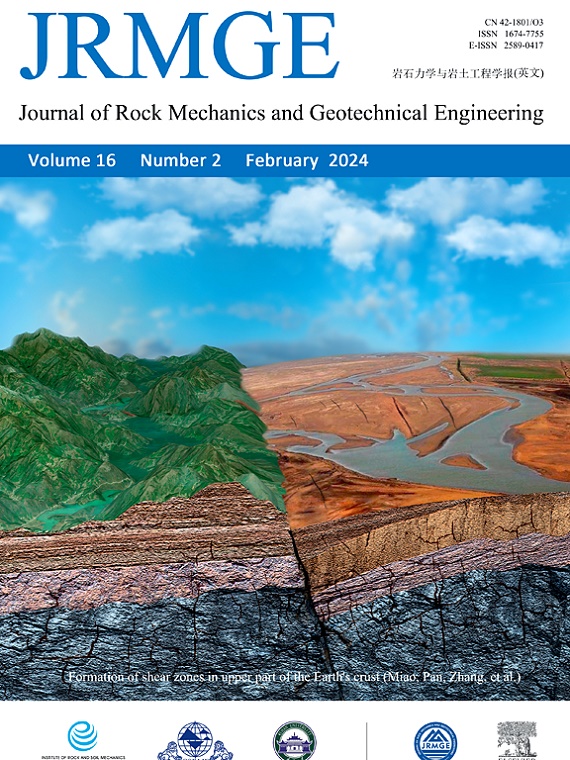Visualization and characterization of experimental hydraulic fractures interacting with karst fracture-cavity distributions
IF 10.2
1区 工程技术
Q1 ENGINEERING, GEOLOGICAL
Journal of Rock Mechanics and Geotechnical Engineering
Pub Date : 2023-11-01
DOI:10.1016/j.jrmge.2023.08.010
引用次数: 0
Abstract
Karst fracture-cavity carbonate reservoirs, in which natural cavities are connected by natural fractures to form cavity clusters in many circumstances, have become significant fields of oil and gas exploration and exploitation. Proppant fracturing is considered as the best method for exploiting carbonate reservoirs; however, previous studies primarily focused on the effects of individual types of geological formations, such as natural fractures or cavities, on fracture propagation. In this study, true-triaxial physical simulation experiments were systematically performed under four types of stress difference conditions after the accurate prefabrication of four types of different fracture-cavity distributions in artificial samples. Subsequently, the interaction mechanism between the hydraulic fractures and fracture-cavity structures was systematically analyzed in combination with the stress distribution, cross-sectional morphology of the main propagation path, and three-dimensional visualization of the overall fracture network. It was found that the propagation of hydraulic fractures near the cavity was inhibited by the stress concentration surrounding the cavity. In contrast, a natural fracture with a smaller approach angle (0° and 30°) around the cavity can alleviate the stress concentration and significantly facilitate the connection with the cavity. In addition, the hydraulic fracture crossed the natural fracture at the 45° approach angle and bypassed the cavity under higher stress difference conditions. A new stimulation effectiveness evaluation index was established based on the stimulated reservoir area (SRA), tortuosity of the hydraulic fractures (T), and connectivity index (CI) of the cavities. These findings provide new insights into the fracturing design of carbonate reservoirs.实验水力裂缝与岩溶缝洞分布相互作用的可视化与表征
岩溶缝洞型碳酸盐岩储集层在许多情况下由天然裂缝连接形成洞群,已成为油气勘探开发的重要领域。支撑剂压裂被认为是开发碳酸盐岩储层的最佳方法;然而,以往的研究主要集中在个别类型的地质构造(如天然裂缝或空腔)对裂缝扩展的影响上。本研究在人工样品中精确预制四种不同缝洞分布后,系统地进行了四种应力差条件下的真三轴物理模拟实验。随后,结合应力分布、主要扩展路径的截面形态和整体裂缝网络的三维可视化,系统分析了水力裂缝与缝腔结构的相互作用机制。研究发现,空腔周围的应力集中抑制了空腔附近水力裂缝的扩展。相比之下,在空腔周围设置较小的进近角(0°和30°)的天然裂缝可以缓解应力集中,显著促进与空腔的连接。此外,在较大应力差条件下,水力裂缝以45°接近角穿过天然裂缝,绕过空腔。基于压裂储层面积(SRA)、水力裂缝弯曲度(T)和空腔连通性指数(CI),建立了新的增产效果评价指标。这些发现为碳酸盐岩储层压裂设计提供了新的见解。
本文章由计算机程序翻译,如有差异,请以英文原文为准。
求助全文
约1分钟内获得全文
求助全文
来源期刊

Journal of Rock Mechanics and Geotechnical Engineering
Earth and Planetary Sciences-Geotechnical Engineering and Engineering Geology
CiteScore
11.60
自引率
6.80%
发文量
227
审稿时长
48 days
期刊介绍:
The Journal of Rock Mechanics and Geotechnical Engineering (JRMGE), overseen by the Institute of Rock and Soil Mechanics, Chinese Academy of Sciences, is dedicated to the latest advancements in rock mechanics and geotechnical engineering. It serves as a platform for global scholars to stay updated on developments in various related fields including soil mechanics, foundation engineering, civil engineering, mining engineering, hydraulic engineering, petroleum engineering, and engineering geology. With a focus on fostering international academic exchange, JRMGE acts as a conduit between theoretical advancements and practical applications. Topics covered include new theories, technologies, methods, experiences, in-situ and laboratory tests, developments, case studies, and timely reviews within the realm of rock mechanics and geotechnical engineering.
 求助内容:
求助内容: 应助结果提醒方式:
应助结果提醒方式:


